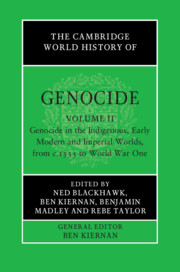Book contents
- The Cambridge World History of Genocide
- The Cambridge World History of Genocide
- The Cambridge World History of Genocide
- Copyright page
- Contents
- Figures
- Maps
- Tables
- Contributors to Volume ii
- Introduction to Volume ii
- Part I Settler Colonialism
- Part II Empire-Building and State Domination
- Part III Nineteenth-Century Frontier Genocides
- 15 The Genocidal French Conquest of Algeria, 1830–1847
- 16 ‘The Bloody Ground’
- 17 ‘A War of Extermination’
- 18 Lessons from Canada
- 19 Frontier Massacres in Australia, 1788–1928
- 20 Genocide in Van Diemen’s Land (Tasmania), 1803–1871
- 21 Genocide in Northern Australia, 1824–1928
- Part IV Premonitions
- Index
19 - Frontier Massacres in Australia, 1788–1928
from Part III - Nineteenth-Century Frontier Genocides
Published online by Cambridge University Press: 23 June 2023
- The Cambridge World History of Genocide
- The Cambridge World History of Genocide
- The Cambridge World History of Genocide
- Copyright page
- Contents
- Figures
- Maps
- Tables
- Contributors to Volume ii
- Introduction to Volume ii
- Part I Settler Colonialism
- Part II Empire-Building and State Domination
- Part III Nineteenth-Century Frontier Genocides
- 15 The Genocidal French Conquest of Algeria, 1830–1847
- 16 ‘The Bloody Ground’
- 17 ‘A War of Extermination’
- 18 Lessons from Canada
- 19 Frontier Massacres in Australia, 1788–1928
- 20 Genocide in Van Diemen’s Land (Tasmania), 1803–1871
- 21 Genocide in Northern Australia, 1824–1928
- Part IV Premonitions
- Index
Summary
Until 1988, little was known about the extent of massacres of Aboriginal people and British settlers across the Australian frontier 1788-1928. Since then the question has dominated Australian historiography and raised the critical question: Were the massacres an expression of genocide? This chapter surveys the debate’s origins in the 1970s and the opposing schools of thought that emerged in response: settler genocide versus Aboriginal resistance. In the 1990s the debate focussed on the level of violence on the colonial frontier in Victoria. A decade later the debate shifted to the colonial frontier in Tasmania and changed direction. Historians of Aboriginal resistance were accused of inventing frontier massacres and fabricating footnotes while others claimed there were very few massacres and the Tasmanian Aboriginal people were responsible for their own demise. In response new methods emerged to understand the characteristics of frontier massacre and interrogate the disparate sources of evidence. New texts argued that frontier massacres were a critical component of Tasmanian Aboriginal dispossession. Today digital mapping technologies have identified more than 300 sites of frontier massacre across Australia, providing new evidence that they constitute genocide.
Keywords
- Type
- Chapter
- Information
- The Cambridge World History of Genocide , pp. 461 - 480Publisher: Cambridge University PressPrint publication year: 2023

